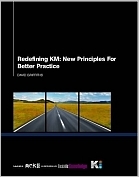| |||||
• polskie
• Zamów informacje o nowościach z wybranego tematu • kontakt |
REDEFINING KM: NEW PRINCIPLES FOR BETTER PRACTICEGRIFFITHS D.wydawnictwo: ARK GROUP, 2011, wydanie Icena netto: Many organisations are cutting back in the areas of human resource development due to global economic stress. This doesn't make it easy for organisations and KM managers who are looking to develop knowledge capacity. This challenge can potentially lead to damaging the organisation's core competitive advantage. It is the organisation that recognises this that will succeed, even in a struggling global economy. Knowledge-hungry organisations need knowledge management (KM) and they need it now. The general opinion is that KM is underperforming. Current models, theories and practices are not working. The KM concept is hard to define and the variables, or components, that make up the process are difficult to identify and measure. This report provides practical solutions to these issues that are slowing the performance of arguably one of the most valuable strategic management tools available to an organisation. Redefining KM provides methodologies and best practices to: - Define and understand current knowledge management strategies; - Identify current KM weak areas within organisations; - Implement KM for performance-driven processes, strategic decision-making and tactical performance; - Understand, implement, and communicate KM as a strategic management tool; - Improve internal control and communication with individuals, teams and management; and external parties; - Nurture individual, group and organisational knowledge and turn it into value-based KM practices. Drawing on original research, surveys, interviews and case studies from large multi-national organisations Redefining KM provides evidence-based KM models and tools to improve KM decision-making and drive performance. Table of Contents Part One: The true definition of knowledge management Chapter 1: Knowledge management today... 3 Why invest in KM?... 4 Methods overview... 4 Chapter 2: The problem with KM... 7 Identifying what needs to be managed... 8 Chapter 3: In search of a knowledge definition that works... 9 Objects and processes - 'Tacit' and 'explicit'... 10 A practical definition of knowledge... 12 Section review... 13 Chapter 4: Understanding the knowledge economy... 15 Economic value drivers... 15 Develop a competitive advantage... 16 Measuring the value of knowledge... 17 Summary... 19 Chapter 5: KM manages knowledge - Get ready for a debate... 21 Is the practitioner managing knowledge, knowledge resources or the environment? ... 21 The complex make-up of KM... 23 Explaining the KM continuum... 23 The techno-centric view... 23 The HR-centric view... 24 True KM - The socio-technological view... 25 The changing face of KM... 25 Redefining KM... 25 Chapter 6: KM critical success factors (CSFs)... 29 Identifying the problem... 32 Training and learning as variables... 33 KM is a system... 34 The need for quality KM literature ... 36 Chapter 7: Too many KM models are not designed to help organisations... 39 Fundamental problems with KM models... 40 Summary and statement of the KM problem... 41 The challenge of the problem... 41 Part Two: Developing a new KM model Chapter 8: Starting from scratch... 45 Initial findings... 46 KM variables and definition... 47 Report limitations... 51 Chapter 9: How do findings compare against existing models and frameworks?... 53 Post-evaluation results... 53 Analysis... 54 Chapter 10: What practitioner opinions revealed... 57 Introducing fractals and self-similarity ... 58 More evidence for common variables... 60 Analysing practitioner feedback... 66 Eliminating knowledge ... 69 Key points... 70 Conclusion... 71 Chapter 11: Introducing the K-Core model... 73 Criticism of new models... 73 Creating the model - The K-Core... 75 Chapter 12: Summary... 79 Part Three: Case studies Case study 1: Jargon PLC ... 83 Jargon project development... 84 Methods... 84 The inquiry framework... 85 Redefining KM: New Principles For Better Practice Findings... 87 Key recommendations delivered to the organisation... 96 Concluding analysis... 101 Case study 2: Trans global pharmaceutical (TGP) - Market expansion... 103 Background... 103 The inquiry framework... 107 Data analysis ... 108 Findings... 109 Recommendations for practice and policy... 113 Part Four: Appendices Appendix 1: Research synthesis - Total findings... 117 Appendix 2: Research synthesis - Range of findings... 119 Index... 121 121 pages, Paperback
Po otrzymaniu zamówienia poinformujemy pocztą e-mail lub telefonicznie, |


